CALLIGRAPHY – The art of giving form to lettering in an expressive, harmonious and skillful manner. Modern calligraphy ranges from functional hand lettered
inscriptions and designs to fine art pieces where the abstract expression of the handwritten mark may or may not supersede the legibility of the letters. While
engraved initials and inscriptions may resemble calligraphy in style, engravers usually refer such work as simply “lettering.”

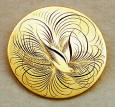
Shown here are an example of pen written calligraphy and jewelry engraved in a calligraphy style of decoration by Steve Lindsay.
|
CALLIGRAPHY TEMPLATE – Another of Steve Lindsay’s specialized templates for graver sharpening that creates a 123 degree point and parallel heel from a
square graver blank. The gravers created from the calligraphy template are used for engraving calligraphy style lettering but are also well suited for flare cuts.
http://www.handengravetools.com/sharpening.htm

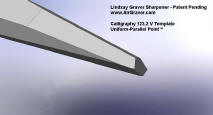
A calligraphy template is pictured here along side the graver point it produces.
|
CAPPED BLOCK – Engraved block letters in which the end of the stems and bars are squared off with a “cap” similar to a Roman serif.
|
CARBALT XD™ - CarbaltXD is the trade name for 3/32” graver blanks made from a proprietary alloy of fine grain carbide and cobalt and manufactured for
Steve Lindsay Engraving & Tools of Kearney, Nebraska.
http://www.handgravers.com/graver-blanks.htm
http://www.engravingforum.com/showth...hlight=carbide
|
CARBIDE – Tungsten carbide, WC, or tungsten semicarbide, W2C, is a chemical compound containing tungsten and carbon, similar to titanium carbide.
Colloquially, tungsten carbide is often simply called carbide. Carbide’s significance in the field of hand engraving is that it is used in graver
blanks. Carbide graver blanks have slightly varying alloys depending on the vendor’s specifications. Carbide gravers must be ground on a silicon carbide
grinding wheel and finish shaped with diamond impregnated laps or hones. Carbide gravers are preferred for engraving precious metals where a polished cut is
desirable and when engraving very hard steels. While extremely hard, carbide gravers are more prone to chip than gravers made of high speed steel especially
when the graver is ground at a narrow angle of less than 96 degrees.
http://en.wikipedia.org/wiki/Tungsten_carbide
|
CARL BLEILE SHARPENING TEMPLATES – Templates designed by engraver Carl B. Bleile of Cincinnati, Ohio and manufactured by Lindsay Engraving and Tools of
Kearney, Nebraska for the uniform and repeatable forming and sharpening of specialized gravers. These tools include deep line, banknote, sculpting, and relief
cutting gravers and a scraper.
http://www.handengravetools.com/sharpening.htm
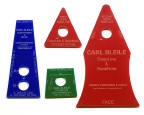
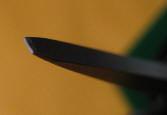

Pictured are an assortment of Carl Bleile templates and two views of a scraper made from Carl's template.
|
CARTOUCHE – An ornate or ornamental frame. An oval or oblong figure enclosing a cipher, initials, monogram, name, or hallmark.


Pictured here are an illustrated laurel wreath cartouche and a cartouche engraved into a trigger guard for later engraving of an initial, cipher or monogram.
|
CARVE, CARVED or CARVING – As used by most engravers, these words mean to decorate by cutting or sculpting any material other than metal,
such as wood, ivory, or stone. There are some engravers, however who use "carving" when referring to sculpted relief decoration, figures and scenes.

Pictured is a beautifully carved game scene on a rifle stock.
|
CELATURE - That which is engraved. Also the act or art of engraving (in relief) or embossing.
|
CELTIC ORNAMENT– A style of ornament originating with the Celtic tribes of Great Britain and Ireland. As used by contemporary engravers, Celtic designs
usually incorporate interwoven knot work or straps, scroll, and zoomorphs. Celtic design is a popular form of decoration on jewelry but less commonly found on
guns and knives.

Pictured are some illustrated examples of Celtic ornament.
|
CERTIFIED PROFESSIONAL ENGRAVER – A designation bestowed upon qualified members of the Firearms Engravers Guild of America. This Designation was superseded
and eliminated in 2009 by the designation of FEGA Master Engraver. See MASTER ENGRAVER.
|
CESELLARE – Italian: Literally chiseling. Italian artisans use this word when referring to relief modeling of metal with punches.
|
CESELLO – Italian: Literally chisel. Italian artisans use this word when referring to any of the specialized punches used in modeled relief of metal
objects.
|
CHASE or CHASING – chasing is the ornamentation of metal by indenting with a hammer or punch from the reverse side. Also known as repousse. Also a
term used by engravers to describe engraving with a hammer and chisel. This term is used because the type of tool employed by hand engravers is called a chasing
hammer.
|
CHASING HAMMER – The hammer used by hand engravers to strike an engraving chisel or a punch. The head of the chasing hammer usually has one circular end
about 1-inch in diameter, and a peening or chasing protrusion on the other end. Some engravers use a hammer with two flat ends of differing diameters. The handle
is usually 5 to 8 inches long and is slim in the middle and bulbous on the end. Italian: Martello, French: Marteaux de gravure, German: Ziselierhammer

Shown here are a light chasing hammer made of bronze with a peening end above a double headed chasing hammer with a steel head.
|
CHINESE WHITE – A watercolor pigment sold in a small block of approximately one square inch. Moisture is applied to the block of Chinese white with a brush
or the finger then the pigment is applied to the metal surface to be engraved. The whitened surface can then be drawn upon or a smoke transfer applied.
|
CHISEL – sometimes called “the long chisel,” this is the arms engraver’s historic and basic tool for executing engraved designs. The length of the chisel
varies from one engraver another, but is usually between the burin and the diesinker’s chisel in length. It can be made with one of several point shapes,
including onglette, round, flat, knife, square, lozenge, bevel, or oval. Most contemporary arms engravers use a tough grade of high-speed steel, carbide, cobalt,
or an alloy of the aforementioned because of the hard metal found in modern firearms. In the USA, the chisel has been largely supplanted by power driven gravers
while the hammer and chisel method still predominates in the UK, Europe, and Asia. Italian: “Punta” (literally means tip).
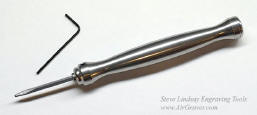

Pictured is a steel chisel handle with removable graver which was designed by Carl Bleile and made by Steve Lindsay Engraving and Tools.
http://www.handgravers.com/Hand_Engr...s_Overview.htm
Also pictured is an assortment of chisels from the bench of Roger Bleile.
|
CIPHER – Two or more unconnected letters that represent the initials of a name. Presentation arms are often engraved with the owner’s ciphered initials.
Often referred to as a monogram though a monogram uses interconnected letters to form a design.
|
CLASSIC AIRGRAVER™ – See
LINDSAY CLASSIC AIRGRAVER

|
CLOSELINED or CLOSELINING – In letter engraving, “clotheslining” or “clotheslined” is a term used to describe the engraving of parallel lines within
the thicker portions of letters to create a bolder appearance to the letters. Also known as “threading.”
|
COBALT GRAVERS - Cobalt gravers are made from an alloy of high-speed steel
and cobalt. Cobalt gravers are used for cutting tough steel alloys. The
names of the two types of high speed steel combined with Cobalt are M35 (5%
cobalt) and M42 (8% cobalt).
Cobalt high-speed steel is widely used in metal manufacturing because of its
ability to resist wear over conventional high speed steels. It is also less
prone to chipping and cost less when compared to the same cutter made of
carbide.
For a period of time before 2001 Cleveland Twist Drill Co. made available
Mo-MaxT HSS cobalt in 3/32" square tool bits (gravers) but no longer does.
Cobalt M42 graver blanks are available from Steve Lindsay Engraving and
Tools at this link:
http://www.handgravers.com/Hand_Engraving_Tools_Overview.htm
|
COCK – On muzzle loading firearms and pin fire rifles and shotguns, the cock is the piece that pivots on an axis to deliver a blow to the percussion cap,
frizzen, or cartridge pin. While commonly engraved, the cocks of some presentation arms are ornately chiseled in the form of fantastic creatures.

Pictured are the cocks of an elaborately chiseled Belgian pin fire shotgun.
|
COLOR CASE HARDENING – A process of surface hardening used in the firearms trade. Color case hardening is sometimes referred to as case colors, color
hardening, or case hardening. It is a heat treatment process whereby the metal (iron or steel) to be hardened is packed into a flask with bone and charcoal and
heated in a furnace. The process and color results vary somewhat by practitioner. The result is a mottled blue-gray finish with a thin surface hardness. Less
frequently known as “carburizing.”

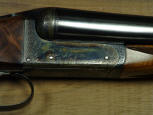
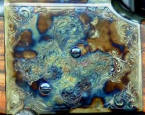
Examples of color case hardening shown here are, an antique Parker shotgun with damascus steel barrels, made in the US, a Roland Watson shotgun made in
Birmingham, England, and a Farquarson rifle made in England but engraved by Carl Bleile and case colored in the US.
|
COROMBELLE – A style of decorative engraving usually found on high quality Belgian shotguns that is attributed to Belgian born engraver Hyppolite
Corombelle (1871-1943). The Corombelle style of engraving incorporates a background fine English scroll over which is superimposed bouquets of flowers, ribbons
and festoons.
Hyppolite Corombelle was the father of the late Lyson Corombelle (1894-1971) who was a highly respected gun engraver in her own right. He was also the founder of
an engraving school in Bologna, Italy where he lived until his death.


Pictured here is a Piotti O/U shotgun engraved by Contissa with a Corombelle motif and the floorplate of an Arietta shotgun decorated by a Spanish engraver with a
version of Corombelle ornament.
|
CROCKER – A hand held, mechanical device with adjustable angles, used for sharpening gravers on a bench stone.

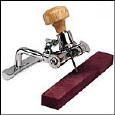
Pictured is a crocker and a crocker with a graver clamped in position for sharpening on a bench stone.
|
CRONITE – See:
ZERO ENGRAVING MACHINE
|
CROSS-HATCHING - Hatching is an artistic technique used to create tonal or shading effects by drawing or engraving closely spaced parallel lines. When such
lines are placed at an angle to one another, it is called cross-hatching. Hatching and cross-hatching are especially important in essentially linear media, such
as drawing, and many forms of printmaking, such as engraving, etching and woodcut. Gun and knife engravers, when referring to the hatching of leaves, flowers and
vines, call this “shading” but the term cross-hatching is still used when the shading or hatching lines are crossed at an angle with additional lines.


Pictured is an engraved portion of an antique revolver with arrows indicating cross-hatching and hatching. The other picture shows a highly magnified portion of a
scroll decoration with hatching for shading effect.
|
CROSS WRIGGLING – A type of fill-in used in relief lettering and in monograms. A liner is used by wriggling in vertical lines first, then wriggling
horizontal lines directly over the vertical lines.
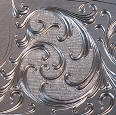
Pictured is a highly magnified section of flare cut scroll by Roger Bleile with a cross wriggled background.
|
CUSTOM CAR ENGRAVING - Some hand engravers specialize in the engraving of custom car parts and accessories. Typically, those parts of a custom car that are
engraved are the engine and running gear as well as a few metal interior components. Those engravers specializing in the custom car field have developed special
work holding fixtures and procedures to accommodate the large and unusual configuration of engine and running gear parts. Accordingly, custom car engravers have
also had to adapt their ornamental designs to their specialty.
Motorcycle and custom car engraving are two of the newest branches of the engraver’s trade. Initially, most of the decorative designs were adapted from the field
of gun engraving but on a larger scale. While this is still the case, some engravers have incorporated other decorative themes such as those prevalent in “biker”
tattoos and “fantasy” art.
|
CUT THROUGH THE BLUE – Gun engravers use this term when referring to engraving done to a gun that has been blued prior to the engraving. As a result the
engraved decoration stands out as if silver against the blued or blackened finish of the gun. While cut through the blue engraving is conspicuously attractive,
the engraver must take care in tool sharpening and cutting to prevent burs since the engraving cannot be polished over without damaging the blued surface of the
gun.
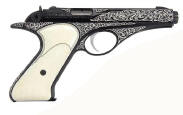
Pictured is an example of "cut through the blue" scroll engraving on a Whitney Worverine .22 caliber pistol.
|
CYCLOIDAL ENGINE - An instrument for engraving bank notes, etc., with complicated patterns of interlacing lines; also called a Geometric lathe. The
decorative borders found on US currency are drawn (in part) by a cycloidal engine; basically a lathe mounted on a pendulum that etched lines on to a metal plate
mounted on another pendulum.
|